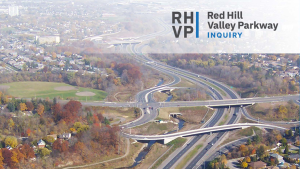A call for asphalt friction safety standards is being discussed in Hamilton, Ont., but where the onus should lay is the burning question.
The issue became front and centre recently when a friction test report on the contentious Red Hill Valley Parkway (RHVP) was never brought to council or disclosed to the public.
The 2013 report from Tradewind Scientific compared sections of the seven kilometre RHVP, that runs between the QEW and Dartnall Road and the adjoining Lincoln Alexander Parkway, to United Kingdom standards to test the slipperiness of the road.
As stated in the report, the U.K. standards were used because, “In Canada and the U.S. there are currently no directly applicable reference standards or guidelines with which to compare data collected by CFME (Continuous Friction Measurement Equipment) for roads and highways, although these are well established for airport runways.”
Tests on the heavily travelled Hamilton parkway were conducted using grip tester friction measurements to compare friction averages to the relevant U.K. investigatory level.
It found overall friction averages as measured by the grip tester were well below or the same as U.K. Investigatory Level 2.
The report’s recommendations included that the city test the friction again, which it never did to the extent Tradewind did in 2013.
It’s pretty frightening to know that there is a lack of consistency and measurability when it comes to the safety on our roads
— Andrea Horwath
Ontario’s Opposition Leader
Given the RHVP’S history and this recent information, Ontario’s Official Opposition Leader Andrea Horwath is calling for a judicial review into the parkway and the buried safety report.
“A newly surfaced 2013 friction test confirms what drivers have known for years, that the parkway’s asphalt is slippery, making it a major safety hazard,” said Horwath in a statement issued by her office.
The statement, issued on behalf of Hamilton NDP MPPs, also says Ontario’s Superior Court should undertake a judicial review of how safety concerns about the roadway were handled, including the lack of disclosure about the 2013 friction test.
“It’s pretty frightening to know that there is a lack of consistency and measurability when it comes to the safety on our roads,” said Horwath when questioned on the issue, adding, “It’s shocking that there is no Ontario standard and I think that there should be an Ontario standard.”
Also calling for consistency is City of Hamilton Ward 4 councillor Sam Merulla, saying, “It is somewhat alarming from a layman’s perspective to know that there isn’t a formal standard born and applied provincially and nationally. Clearing the science behind friction testing of asphalt is one important variable of assessing public safety on roads. The industry should make provincial and or Canadian standards a priority.”
From a provincial standpoint, the Ministry of Transportation feels the responsibility should lie at the municipal level.
“The Red Hill Valley Parkway is a municipal road. The City of Hamilton is responsible for operating and maintaining it. The ministry has no plans to implement municipal roadway friction testing. All municipalities will continue to be required to meet the Minimum Maintenance Standards for municipal highways,” said Ontario Ministry of Transportation spokesperson Bob Nichols.
He also said the ministry has offered technical assistance to the City of Hamilton and had no role in the 2013 Tradewind Scientific study.
The reason behind the report being hidden for so long remains unanswered, but the city did spring into action once it came to light by holding a marathon council meeting to bring forth recommendations.
Those recommendations include the release of two additional reports by external traffic engineering experts, CIMA.
The most recent report from October 2018 recommends a review of the mainline and all on and off ramps on the RHVP and correcting deficiencies as well as upgrading roadside safety devices to current standards.
“The city is sharing the roadside safety assessment recommendations, which will be incorporated as part of the upcoming resurfacing project or reviewed as part of a functional design study for the RHVP, ” said City of Hamilton spokesperson Jasmine Graham in a news release.
The second CIMA report, which was made public in December 2015, includes already implemented traffic safety recommendations that include the installation of oversized speed limit signs, the installation of slippery when wet signs and speed fine signs.
Well before the 2013 report surfaced, the city had approved a $15 million resurfacing project of the RHVP this summer. Reasons for the substantial paving project included repair and maintenance of the 11-year-old expressway and quality of the asphalt coming into question after it was concluded that over its lifespan there have been twice as many vehicular accidents on the RHVP than on the connecting Lincoln Alexander Parkway.
The city has also approved a bylaw that formally reduces the speed limit on the RHVP to 80 km/h from the previous 90 km/h.






Recent Comments
comments for this post are closed